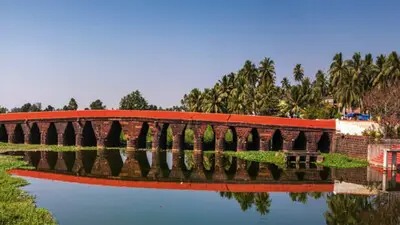 Image Source : OdishaTV
Image Source : OdishaTV
The Atharanala Bridge in Puri, Odisha, is a remarkable 13th-century architectural marvel that continues to serve as a vital passage for pilgrims heading to the revered Jagannath Temple. Built during the reign of King Narasimha Deva I of the Eastern Ganga dynasty, this historic structure showcases medieval engineering brilliance and deep cultural significance.
Architectural significance
- The bridge spans approximately 85 meters in length and 12 meters in width, featuring eighteen arches that give it its name—Athara meaning eighteen and Nala meaning channels in Odia.
- Constructed using laterite stone and lime mortar, its arched design aids in water drainage and enhances structural durability.
- The bridge’s ashlar masonry and multi-arched format not only serve functional purposes but also create a visually striking presence, evoking a sense of grandeur.
Cultural and religious importance
- Atharanala has long been a key entry point into Puri, facilitating pilgrimage and trade for centuries.
- Devotees crossing the bridge as part of their journey to worship Lord Jagannath consider it more than just a transport link—it is a spiritual corridor steeped in devotion and ritual.
- The bridge offers a spectacular long-distance view of the Jagannath Temple, further enhancing its significance for visitors.
Preservation and recognition
- The Archaeological Survey of India (ASI) has declared Atharanala a Monument of National Importance, acknowledging its historical value.
- Conservation efforts are ongoing to protect the bridge from weathering and urban encroachment, ensuring its longevity for future generations.
- Restoration initiatives aim to maintain its structural integrity while preserving its original aesthetics, keeping its legacy intact.
Future outlook
- Atharanala remains a symbol of Odisha’s architectural heritage and religious devotion, drawing historians, pilgrims, and tourists alike.
- As efforts continue to safeguard its historical essence, the bridge stands as a testament to the ingenuity and craftsmanship of medieval India.
Sources: OdishaTV, Archaeological Survey of India, Jagannath Sanskruti
Advertisement
Advertisement







